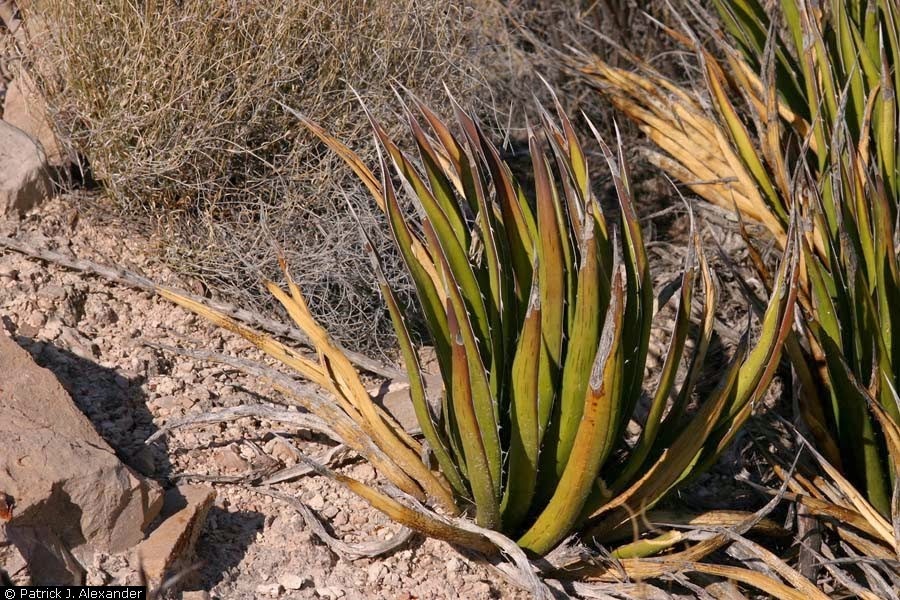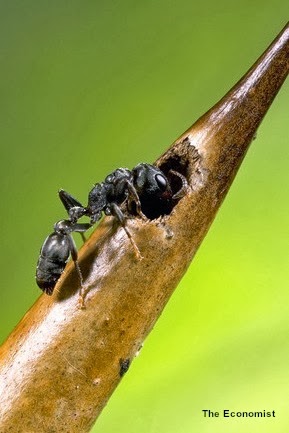 |
So-called “fragile” prickly pear (Opuntia fragilis) takes revenge on an unsuspecting botanist.
|
Plants have lots of vexing and painful parts -- spines, thorns, barbs, prickles, glochids, retrorse hairs and dangerously-sharp leaf tips. As biologists we assume these are adaptations, but for what? It’s tempting to think defense.
 |
The leaf tips of Agave lechuguilla, shin dagger, can be deadly. From USDA Plants.
|
 |
| Retrorse barbs of wild licorice (Glycyrrhiza lepidota) look nasty ... |
 |
| ... but they're only a few mm long, as seen here in context (dog fur). |
 |
Puncturevine nutlets are especially devilish (Tribulus terrestris; source).
|
 |
| Puncture vine mat and closeup of flower. Flowers are 0.5-1 cm across. Source. |
The most infamous pain-inflicting plants in North America are cacti, with their diverse assortment of spines. Surely they are adaptations to discourage animals from eating the delectable fleshy stems, so appealing in deserts. This is a reasonable conclusion.
 |
Prickly pear cacti have tiny very sharp spines called glochids below the regular spines. They're especially difficult to remove from skin. Some cultivars are spine-free -- these are the tasty nopales or indian figs.
|
However there seem to be other “purposes” for cactus spines as well as defense. Consider that they’re found mainly in deserts -- plants of moister regions are rarely covered with spines. Might spines shade stems and reduce water loss? For the fragile prickly pear (beginning of post) and the infamous jumping cholla of Arizona (below), they appear to be "for" dispersal. Stem segments readily disarticulate, and can attach to an unsuspecting passerby thanks to the spines.
Though many purposes can be conjured up by a curious partially-informed mind, it’s difficult to know why a plant structure evolved -- what it’s an adaptation for. We rarely understand the evolutionary history of adaptive traits. For example, something may have evolved for an unknown purpose long ago, and later was co-opted or redesigned for something else. The opportunities for speculation are infinite. There’s a thought-provoking discussion about this dilemma at The Mermaid’s Tale: Why do cholla cacti use torture?, written by Anne Buchanan after a hike in the Arizona desert.
“The problem is that there may be no single reason, nor even any single kind of history involved here. ... we think this illustrates why, even when the assumption that the trait is 'adaptive'--that is, is here ultimately because of natural selection--that assumption is hard to prove and in particular the reason is hard to be sure about.”[Warning: the included video featuring an unfortunate victim of cholla torture is not for the squeamish.]
 |
Jumping cholla, Cylindropuntia fulgida. Source.
|
Obviously we need to be cautious, not just in walking through dangerous plants but also in thinking about them. Like so many biological phenomena, the more we learn, the more complicated it gets [sigh] but of course that makes the stories even more wonderful! Here’s a great example:
 |
Bullhorn acacia, Acacia hindsii.
|
The bullhorn acacia is a well-armed desert tree, with long spines that deter browsers in ways both obvious and surprising. Obviously the sharp-tipped spines discourage larger animals, but they don’t do much against insect pests and fungal pathogens. Fortunately they also serve as ant homes, and in fact, the acacias strive to make the neighborhood attractive to ants by providing nutritious food via extrafloral nectaries. It’s worth the investment. The ants sting anything that tries to eat the leaves, from caterpillars to cattle. Furthermore, acacias with healthy populations of the right kind of ant have a reliable supply of antibiotics to fight fungal infections on their leaves. Their drugs are produced by bacteria living on the ants’ legs. What a nice arrangement! For more, see The Economist, Protect and Survive; and Science Daily, Ants protect acacia plants.
✿✿✿✿✿✿✿✿✿
This post is my submission to this month’s Berry Go Round, a blog carnival for plant lovers. It’s hosted by Garry Rogers, and the topic is Botanical Warfare.
 |
Spines are for beauty too -- for those who look close (from Excruciatingly Beautiful).
|

Fine post, Hollis. I resonate with this sentence particularly: Like so many biological phenomena, the more we learn, the more complicated it gets [sigh] but of course that makes the stories even more wonderful!
ReplyDeleteThanks, Anne.
ReplyDeleteA really interesting post with superb photos.
ReplyDeleteThanks, chloris, for reading and for the kind comment!
Delete